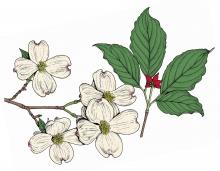Trees, Shrubs and Woody Vines
Media

Species Types
Scientific Name
Carya spp.
Description
Hickories are an important part of Missouri’s oak-hickory woodlands and forests. They have tremendous economic value, too. Learn about the nine species of hickory found in Missouri.
Media

Species Types
Scientific Name
Quercus spp.
Description
Oaks are the most important group of trees in Missouri, in both human and ecosystem value. They dominate most of the forests, woodlands, and savannas in the state. Learn more about our 22 species.
Media

Species Types
Scientific Name
Cercis canadensis
Description
Eastern redbud is a native shrub or small tree that is distinctly ornamental in spring with small, clustered, rose-purple flowers covering the bare branches before the leaves.
Media

Species Types
Scientific Name
Quercus marilandica
Description
Blackjack oak is common in dry upland woods, especially ones that have been badly burned. It can grow on the poorest soils. It is rugged but not worth much as lumber. It's one of the first trees to be used as fuel.
Media

Species Types
Scientific Name
Sassafras albidum
Description
Sassafras, with its aromatic oval, mitten- , and trident-shaped leaves, is rich in both human and natural history, and it can be a spectacular tree for fall color.
Media

Species Types
Scientific Name
Elaeagnus umbellata
Description
Autumn olive can be found all over the state, since it was planted widely with the best of intentions. Despite its “pros,” this shrub has proven to be very invasive. It threatens native ecosystems and should not be planted.
Media

Species Types
Scientific Name
Lonicera maackii (Amur) and Lonicera x bella (bella)
Description
If there’s a giant green thicket in your woods, you may have a bush honeysuckle infestation. These invasive plants are shrubby natives of Asia. In America, where they have no natural controls, they leaf out early, grow fast, spread fast, and form dense thickets that crowd out native forest plants.
Media

Species Types
Scientific Name
Cornus florida
Description
Flowering dogwood is a beautiful shrub to small tree with a straggling, spreading crown. Missouri’s official state tree, it presents lovely boughs of white inflorescences in springtime forests.
Media

Species Types
Scientific Name
Quercus prinoides
Description
The dwarf chestnut oak, though only 3–10 feet tall and the shortest of Missouri's oaks, can nevertheless produce abundant acorns that are relished by several types of birds and mammals.
Media

Species Types
Scientific Name
Diospyros virginiana
Description
Persimmon is best known in the fall, when its orange, plumlike fruits come on. Be careful, however, to make sure a persimmon is ripe before you pop it into your mouth, or you could have a puckery surprise!
See Also
About Trees, Shrubs and Woody Vines in Missouri
There are no sharp dividing lines between trees, shrubs, and woody vines, or even between woody and nonwoody plants. “Wood” is a type of tissue made of cellulose and lignin that many plants develop as they mature — whether they are “woody” or not. Trees are woody plants over 13 feet tall with a single trunk. Shrubs are less than 13 feet tall, with multiple stems. Vines require support or else sprawl over the ground.





















